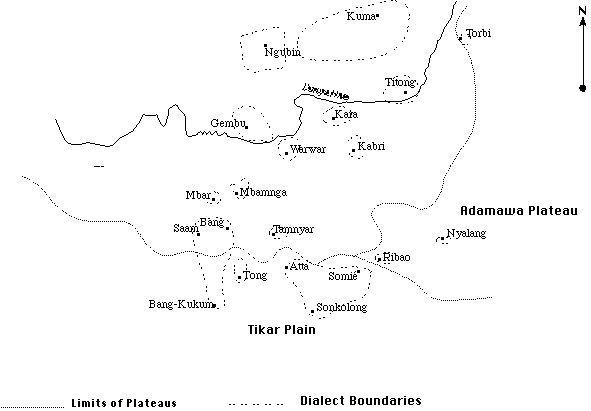
Convergence and divergence in the development of Mambila
Bruce Connell
University of Oxford
Text of a paper presented at the 26th Colloquium on African Languages and Linguistics, Leiden, The Netherlands, Sept. 5-7 1996.
Comments and discussion welcome
1. Introduction
The Mambila language comprises a cluster of dialects which straddle the Nigeria-Cameroon border. Together with several neighbouring languages, it is classified as Mambiloid and therefore part of the North Bantoid branch of Bantoid (Blench 1993). Geographically, the Mambila region is diverse, divided between the mountainous Mambila Plateau in Nigeria and the Adamawa Plateau and Tikar Plain in Cameroon. The escarpments forming this division, roughly speaking, determine the political frontier. For the most part the Mambiloid languages are located in the mountainous region, though some are spoken on the Tikar Plain.
One of the striking aspects of Mambila is its apparent internal diversity - Blench (1993), for example, regards it as the most diverse of the Mambiloid languages. The accepted view regarding this heterogeneity, established by Perrin & Hill (1969) and fostered by Zeitlyn (1991) as well as Blench, is that there is a basic division among the dialects giving two clusters. The boundary between the two essentially corresponds to the major geographical division between the Mambila Plateau and the Tikar Plain. Earlier, Meek (1931) also suggested a fundamental two-way split, though one that had little in common with that eventually proposed in Perrin & Hill. Figure One shows the approximate distribution of Mambila dialects - `speech communities' might be a better term at this point since, rather than being based on an assessment of linguistic features, their identity comes primarily from reports of Mambila speakers as to who they feel speak the same or different dialects. Figure One makes no direct reference to the groupings postulated by either Perrin and Hill or Meek.

Figure One: Distribution of Mambila dialects (speech communities).
The questions addressed in this paper are:
1) given the diverging opinions of Perrin & Hill on one hand, and Meek on the other, is there actually a fundamental two-way split in Mambila dialects or is the situation more complex, such as a three-way split? The answer to this is that the situation is in fact more complex than has been reported previously, but there is a significant two-way split, though not exactly that envisaged by any of the previous researchers. The first part of the paper is devoted to establishing the division.
2) Accepting that an affirmative answer to question (1) is supported, a second and more interesting question is addressed: what are the factors and processes that have led to the present situation? Does this division exist primarily as a result of divergence - the break-up of proto-Mambila - or is it due to convergence: two or more formerly distinct languages influencing each other to the point where they are now considered to be dialects or dialect clusters of the same language? Since this latter proposal is in a sense the non-traditional one, in the second part of the talk, I will justify it before going on to propose a hybrid or compound answer to the question of divergence or convergence.
3) Accepting the Mambila situation reveals processes of both divergence and convergence, what can this study tell us about the dynamics of language change more generally?
The research reported here is based on field work carried out in the Mambila region over the past two years. The database used consists primarily of a comparative wordlist of approximately 1,000 words for each of more than 30 languages or dialects, together with data on their morphological and syntactic characteristics. Conclusions presented are based on an examination of phonological, morphological and lexical characteristics.
2. A Two-way division among Mambila dialects
Mambila can be characterized as comprising two clusters of dialects, the division between the two being formed by a number of phonological, morphological, and lexical isoglosses. When these isoglosses are considered together we find, not surprisingly, there is no sharp boundary between the two clusters but, rather, a transition zone. We also find that neither Perrin & Hill (1969) nor Meek (1931) were entirely correct in their different assessments of the situation. The reasons for their misconception of the situation are not crucial, but apparently have more to do with insufficient data rather than inaccurate analysis of available data. If Meek's assessment appears in some respects to be closer to the actual situation as revealed by the present research, this is due only to the range of dialects he was able to consider. It is interesting to note that a close reading of his work suggests his opinion was based as much or more on ethnological or cultural characteristics as on linguistic features (as well as a tacit assumption concerning the relation between language and culture). For clarity and ease of presentation, in the discussion that follows only some of the dialects thus far investigated are included, and only a few of the possible isoglosses are discussed. Mambila dialects not discussed here are nevertheless included on the map in Figure One. In addition to these, other languages in the region include Mbongno, Mvano, Tep, and Somyev all of which are spoken on the Mambila plateau and are related to Mambila (i.e. are considered to be Mambiloid; cf. Blench 1993). Also thought to be Mambiloid, but spoken on the Adamawa Plateau or Tikar Plain, are Kwanja, Wawa, and Vute. Other non-Mambiloid languages with which Mambila speakers may come into more or less regular contact include Tikar (on the Tikar Plain), Yamba (scattered throughout the Mambila area), Fulfulde (the regional lingua franca), as well as English (in Nigeria) and French (in Cameroon) and Pidgin.
2.1. Phonological isoglosses
Figure Two illustrates some of a number of phonological isoglosses linking Mambila dialects. These obviously present only a partial story, but do highlight the major division within Mambila. Others which could be added to the map would serve either to reinforce the major boundary or to establish the existence of smaller units within the two larger groupings.
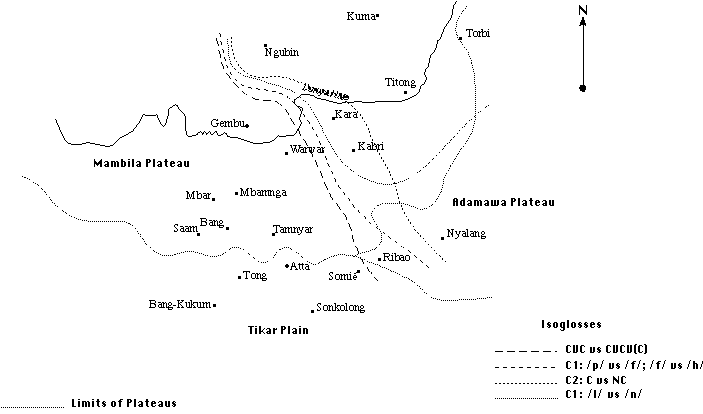
Figure Two: Some isoglosses among Mambila dialects.
The most striking of these isoglosses represents a difference in word structure: dialects which show a C1V1C2 structure corresponding to a C1V1C2V2(C3) structure in cognate words in other dialects. Table One presents examples of this from Bang, Mbar, Gembu and Somié (CVC) and Ribao, Kabri, Kara, Titong, Twendi, and Nyalang (CVCV(C)). I will characterize these two groups with reference to their word for `dog': the Bor cluster vs the Bundu cluster. Within the Bundu cluster there is a division corresponding to whether C2, in CVCV(C) words, is prenasalized. This division is indicated in Table One with the examples from Kara on one hand (oral C2) and Titong (prenasalized C2) on the other. From the evidence in Table One, the inclusion of Somié and, perhaps less problematic, of Gembu in the Bor cluster may need to be justified, given the existence of CVCV forms in these dialects. These are in fact relatively infrequent in these dialects, and appear to reflect the last stages of the change of CVCV to CVC. The phonological considerations governing this change are discussed below.
The Bor vs Bundu division is paralleled by two other isoglosses pertaining to C1: /p/ vs /f/ (one item only, but note initial /p/ is rare) and /f/ vs /h/. The exception to this is Ribao, which follows the Bor cluster in this respect. Examples of these are in Table Two. Another isogloss broadly follows this pattern but, in addition to Ribao, Twendi and Nyalang are also on the Bor side of the divide. This again has to do with C1, and represents an /l/ vs /n/ correspondence. Examples are given in Table Three.
Table One: CVC vs CV(N)CV word structure
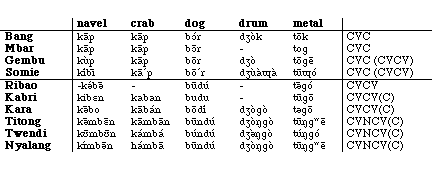
Table Two: C1 /p/ vs /f/ and /f/ vs /h/
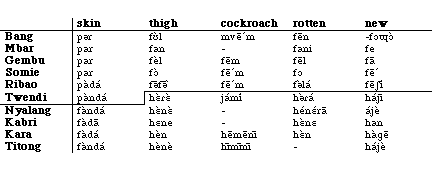
Table Three: C1 /l/ vs /n/
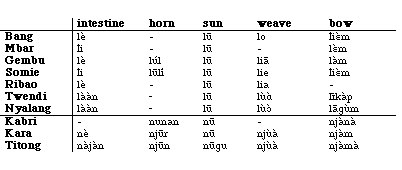
In considering these correspondences, we can assume that:
a) CVCV(C) rather than CVC represents the more conservative form (otherwise the variation in the transition zone would not exist);
b) prenasalization of C2 reflects the older form;
c) with respect to /p/ vs /f/ and /f/ vs /h/, /p/ and /f/, respectively, reflect the earlier forms;
d) with respect to /l/ vs /n/, /l/ reflects the older form.
The changes described in (a), (b), and (c) all represent
weakening processes generally considered to be the most common of
sound change processes; in the absence of evidence to the
contrary, we therefore assume the directionality expressed here
to be accurate. In the case of (d), however, it is not clear that
either direction, /l/ > /n/ or /n/ >
/l/ is to be more expected on such a general principle.
The former of these two possibilities is accepted here for two
reasons: first, the roots found for `intestine' and `weave' are
ancient roots, found with /l/ as C1 in such divergent
language groups as Ijoid (Williamson, per. comm.; cf. Defaka
 , `weave') and Lower Cross
(PLC
, `weave') and Lower Cross
(PLC  `weave'); second,
the presence of a nasal in C2 or C3 provides evidence of a
conditioning environment, which would have precipitated a change
of /l/ > /n/.
`weave'); second,
the presence of a nasal in C2 or C3 provides evidence of a
conditioning environment, which would have precipitated a change
of /l/ > /n/.
These developments show two different centers/trajectories: for (a) and (b), the more conservative form is located to the east of the isogloss, i.e. the innovation is apparently moving from west to east, while (c) and (d) have the older form to the west of the isogloss and the innovation appears to be spreading from the east.
2.2 Morphological differences
Evidence for the proposed dialect division also appears in differences in morphology; we look here at affixes used for pluralization and nominalization or infinitive formation. In both cases the differences found are also accompanied by characteristics common to the two groups.
2.2.1. Pluralization: The most common form of nominal pluralization in Mambila is through the suffixation of -VB, as a generalized plural marker. Given the existence of other more varied means of indicating plurality, use of this marker may be a relatively recent development, and conceivably one which may have spread from one cluster to the other. Alternatively, it may have come to both from a third source, as it is widespread in the region and appears to cross several linguistic boundaries (Blench per. comm.; cf. Boyd 1994). Williamson (1971) draws attention to the similarity this suffix shows with the Bantu plural personal prefix ba-, and suggests that this marker may have become generalized. What are probably remnants of an earlier system of pluralization are still in evidence, and in fact are still functional in several dialects, mostly Bundu, at least for older speakers. This system also involves suffixation, of -VB, and shows some commonality not only across both Bor and Bundu clusters, but also in related Mambiloid languages such as Vute. It may be assumed, then, that -VB goes back to a common Mambiloid parent. The widespread distribution of -bV, however, suggests that there may be a long-standing alternation between it and -VB, though the latter is now clearly in decline. Apart from these, there some affixes found in only one cluster or the other, as well as some which seem to be dialect specific. The affixes used are laid out in Table Four.
Table Four: Plural Morphemes in Mambila dialects

There are two suffixes that appear only in the Bundu cluster,
though neither of these are found throughout the cluster. One,
 , may eventually prove to
be an allomorph of -VB, though at present there is no
obvious conditioning environment for this, whereas other variants
(not included in the table) clearly are allomorphs. The other,
, may eventually prove to
be an allomorph of -VB, though at present there is no
obvious conditioning environment for this, whereas other variants
(not included in the table) clearly are allomorphs. The other,
 , may also have a
cognate form in Vute, and if so would presumably again be a
retention from proto-Mambiloid. Interestingly, the occurrence of
, may also have a
cognate form in Vute, and if so would presumably again be a
retention from proto-Mambiloid. Interestingly, the occurrence of
 corresponds precisely
to the /l/ vs /n/ isogloss discussed earlier,
defining a subset within the Bundu cluster. Within the Bor
cluster it is notable that a subset of dialects utilize
prefixation rather than suffixation, and that these are for the
most part dialects located on the Tikar plain. Somié uses
two prefixes, the second of which,
corresponds precisely
to the /l/ vs /n/ isogloss discussed earlier,
defining a subset within the Bundu cluster. Within the Bor
cluster it is notable that a subset of dialects utilize
prefixation rather than suffixation, and that these are for the
most part dialects located on the Tikar plain. Somié uses
two prefixes, the second of which,  , is restricted to [+human] nouns. The same is true
of Bang-Saam (which uses a suffix,
, is restricted to [+human] nouns. The same is true
of Bang-Saam (which uses a suffix,  , generally, and -bV rarely) while
Bang-Kukum has apparently generalized the
, generally, and -bV rarely) while
Bang-Kukum has apparently generalized the  prefix.
prefix.
2.2.2. Nominalization: A similar situation exists with respect to the nominalizing (infinitival) affix. One suffix, -ne (or cognate form) is found in both clusters (but not universally), and like the -VB plural suffix, it may be seen as going back to a common Mambiloid parent, as it also occurs in neighbouring related languages such as Vute and Kwanja. There are as well, however, affixes particular to one or the other cluster. Most noticeably different of these are in again Bang, where infinitive formation is typically done through addition of a prefix e- and the addition of a low tone (T4) to the last vowel of the stem[1]. Similarly, Somié employs the addition of a low tone, and it is probable that in both cases the tone is a remnant of a suffix which has lost its segmental content.
The morphological evidence, despite characteristics particular to one dialect or subsets of dialects within one cluster or the other, has characteristics that not only span the two clusters but are as well found in other neighbouring languages. The best assessment at present is that there has been no borrowing other than of the plural marker -BV, which is a widespread areal feature.
Table Five: Nominalizing affixes (infinitive formation)

2.3. Lexical differences
At the present stage of research it is difficult to identify clear cut lexical isoglosses that distinguish anything more than a couple of (usually adjacent) dialects, and at least superficially the opinion of Nichols (in press), that the "... movement of loan vocabulary in cases of diffusion is notoriously chaotic: borrowings go in various directions, each borrowing language rephonemicizes or reanalyzes or more generally garbles its borrowed words, and each language contributes some of its own native stock to others as well as passing on some borrowed words", seems to be well supported. Nevertheless, there is a small number of lexical isoglosses which at least roughly appear to characterize one cluster as opposed to the other (see Table Six), and it should prove possible eventually to sort out and trace the trajectories along which loan words have moved, thereby giving greater insight into the earlier nature of the lexicon of Mambila, as well as the interactions and contacts among the various groups in the region.
Table Six: Some lexical differences
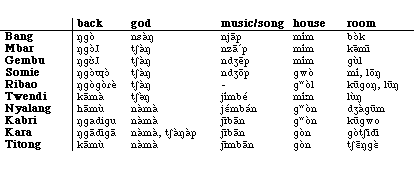
3. Divergence or convergence?
On balance, the evidence shows Mambila can be seen as having two major dialect clusters. A more detailed analysis would obviously permit a better understanding of the differences that exist between and within the two clusters, and this work is in progress. One problem now is to understand the processes that have led to the present situation, and specifically, whether or to what extent this bipartite division exists as a result of diversification and change - the break-up of proto-Mambila - or as a result of other processes, such as convergence or a shift in either or both of language and ethnic identity, resulting in two or more formerly distinct languages influencing each other to the point where they are now considered to be dialects or dialect clusters of the same language. Apart from general considerations, there are some specific reasons why the possibility of convergence needs to be considered.
First, the fact that there are two centers of diffusion for the phonological innovations suggests the possibility of convergence of formerly distinct languages. This of course is not conclusive evidence, but nevertheless the possibility must be considered. Second, Meek's dialect division, which partially corresponds to that presented here, is to a large extent based on cultural differences - e.g. differences in religion and architecture[2] - of the sort that are frequently associated with different ethnic identities, and therefore conceivably different languages. Again, this is not conclusive evidence, but it does suggest the possibility of two languages converging needs to be considered. Also, the Mambila (i.e. those now recognized as Mambila) are not known to have had a common ethnonym until recent times, though Meek claimed indigenous group names that corresponded (at least approximately) to the two major dialect clusters identified here (Torbi and Tongbo for Bundu and Bor, respectively). These clearly do not apply to the two clusters today and probably never did, as each is a name particular to a smaller group within each cluster, and within Mambila we find names for the smaller dialect groupings, referred to above as speech communities. Obviously none of the above factors constitute more than weak evidence, at best, that what is now recognized as one language, Mambila, was in earlier times two distinct languages. Nevertheless, when these factors are considered together, the possibility that what were once two relatively autonomous groups that came to recognize themselves as more of a single entity, especially vis à vis the incoming Fulani, cannot be discounted out of hand. What might once have been seen as two different languages, each with its own inherent dialect variation, then, came to be regarded as two dialect clusters of one language through a shift of perceived ethnic identity. This shift in identity has perhaps then facilitated a convergence of linguistic features. Aspects of this scenario are not unfamiliar, as they at least superficially resemble the development of French and the bundle of isoglosses that define the division of vernacular French into langue d'oc and langue d'oeil. Indeed, like these two, the Bor and Bundu dialect clusters, despite their differences, must still go back to a common parent, and are best seen as being closer to each other than any other language.
There is yet an additional reason for considering alternatives to the traditional view of language development as being merely the break-up of a parent language. Local oral tradition gives evidence of movement and admixture among the various groups living in the Mambila region. This movement has involved groups of speakers of different `Mambila' dialects (and possibly others) coming together, resulting in situations of language contact, and it is inconceivable that such a situation would not give rise to language change, perhaps even to the extent of creating new hybrid varieties of Mambila. The extent to which convergence of this nature might have happened is an empirical question.
Insight into this question can be had in considering Somié which, although here grouped with the Bor cluster, does show some evidence of transitionality with regard to some of the isoglosses identified above (e.g. the existence of both CVC and CVCV forms where ideally only CVC forms should be expected). There is evidence in the local oral tradition of different (presumably) Mambila clans in the background of the current Somié population: Liap, Mvop, Ndeba, and Njerep are all mentioned (cf. Zeitlyn 1992) has having at different times formed part of the village[3]. And while the oral tradition is not clear as to the precise provenance of each of these, it is entirely plausible that the variation demonstrated above for Somié reflects influences contributed by different waves of immigrants. There are for example still a few people in Somié who consider themselves to be Njerep and remember their dialect; this dialect shows clear affinities with the Bundu cluster, and of these most closely with Nyalang and Twendi (cf. (Connell, 1995). It is unlikely, however, that the variation found in Somié between CVC and CVCV structures (see Table One), can be attributed to layers or strata contributed by different groups. In Somié, whether a given word is CVC or has retained CVCV is related to its phonological structure, and as such, the development appears to be phonetically driven. That is, labial C2, with a preceding high front vowel, is most conservative in retaining V2, and alveolar most innovative (V2 is lost in virtually all cases), while velar is weakened almost to the point of disappearance (it is realized as a velar approximant) in low vowel environments. In addition, at least for some speakers, V2 is optional in those words where it occurs following a velar in the examples in Table One, in which case the velar surfaces as a stop. It is difficult to reconcile these facts with a scenario based on convergence or borrowing - there is no reason why words of different structural types should be borrowed differentially according to the place of articulation of C2. The variation does seem more consistent with viewing this as a change which is spreading gradually, both within individual dialects and across the geographical region, and which is governed by phonetic environment[4]. Gembu and Mbamnga also follow this pattern but appear to be somewhat more advanced than Somié, while Bang has completed the development, having lost V2 in all relevant lexical items.
Similarly, the phonological developments illustrated in Tables Two and Three can be said to be gradual developments, changes that are spreading across the region. All of these can be said to represent a converging of dialects in that one dialect is influencing another.
On the other hand, examination of the lexical items in Table
Six suggests Somié has some words contributed from one
source (e.g.  `house',
which is likely cognate with words for house in dialects of the
Bundu cluster) and others from a different source (e.g.
`house',
which is likely cognate with words for house in dialects of the
Bundu cluster) and others from a different source (e.g.  `god',
`god',  `music', both of which are cognate with words
found in dialects of the Bor cluster). This possibly does reflect
contributions from different waves of immigrants, i.e different
strata in the lexicon.
`music', both of which are cognate with words
found in dialects of the Bor cluster). This possibly does reflect
contributions from different waves of immigrants, i.e different
strata in the lexicon.
4. Conclusion
There is evidence for both divergence and convergence in the development of Mambila. Perhaps not surprisingly, these two types of processes assume different degrees of importance at different levels of linguistic structure (cf. Connell, in press). Convergence appears most readily in the lexicon, while its effects with respect to phonological developments move more slowly. Morphological developments appear most resistant to convergence (with the exception of the generalized plural marker), only showing innovations in what appear to be divergent developments.
References
Blench, R. M. (1993) An outline classification of the Mambiloid languages. Journal of West African Languages, XXIII 1, 105-118.
Boyd, Raymond (1994) Historical Perspectives on Chamba Daka. Köln: Rüdiger Köppe Verlag.
Connell, Bruce (1995) Dying Languages and the Complexity of the Mambiloid Group. Paper presented to the 25th Colloquium on African Languages and Linguistics, Leiden, Sept. 1995.
Connell, Bruce (in press) The role of language contact in the development of Usaghade. Sprache und Geschicte in Afrika, 16.
Meek, C. K. (1931) Tribal Studies in Northern Nigeria. London: Kegan Paul.
Nichols, Johanna (in press) The epicenter of the Indo-European linguistic spread. In R. M. Blench, & M. Spriggs (Ed.), Archaeology and Language, Vol. II. Routledge One World Archaeology Series. London: Routledge.
Perrin, Mona & Hill, Margaret (1969) Mambila (Parler d'Atta): Description Phonologique. Yaoundé: Universite Federale du Cameroun.
Williamson, Kay (1971) The Benue-Congo Languages and Ijo. In T. Sebeok (Ed.), Current Trends in Linguistics (pp. 245-306). The Hague: Mouton.
Zeitlyn, David (1992) Un fragment de l'histoire des Mambila: un texte de Duabang. Journal des africanistes, 62 1, 135-150.
Zeitlyn, David (1994) Sua in Somié. Mambila Traditional Religion (Collectanea Instituti Anthropos 41). Sint Augustin: Academia Verlag.